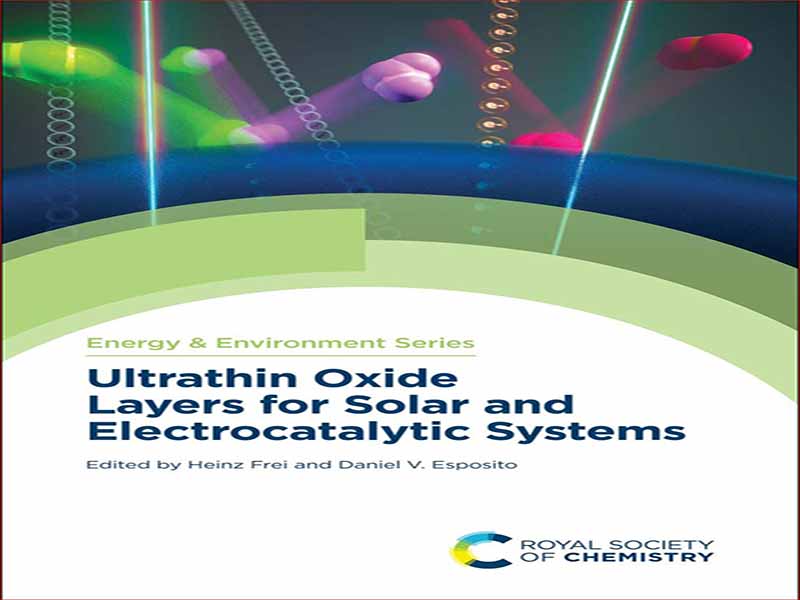- عنوان مجله: Ultrathin Oxide Layers for Solar and Electrocatalytic Systems
- نویسنده: Heinz Frei
- حوزه: َانرژی خورشیدی
- سال انتشار: 2022
- تعداد صفحه: 378
- زبان اصلی: انگلیسی
- نوع فایل: pdf
- حجم فایل: 14.1 مگابایت
اگر تنها یک عامل مهم وجود داشته باشد که باعث توسعه لایه های اکسید فوق نازک برای پیشبرد سیستم های کاتالیزوری عکس، الکترو و حرارتی برای انرژی شده است، آن تولد و رشد انفجاری در زمینه علوم نانو است که از دهه 1990 شروع شد. این امر قابلیت سنتز و دستکاری مواد معدنی را در مقیاس طولی نانومتری باز کرد، که مقیاسی است که در آن انتقال بار، انتقال یون و تبدیلهای شیمیایی برای طراحی و بهینهسازی سیستمهای کاتالیزوری برای کاربردهای تبدیل انرژی باید کنترل شود. ظهور همزمان مجموعهای از ابزارهای مشخصهیابی جدید، از میکروسکوپهای پیشرفته الکترونی و تونلی گرفته تا طیفسنجی پرتو ایکس و میکروسکوپ نوری با وضوح فوقالعاده، به محققان این امکان را میدهد که ساختارهای نانو اندازه را در وضوح اتمی مشخص کنند و درک فیزیک و شیمی بنیادی را تسریع کنند. زیربنای علم نانو و فناوری نانو است. پیشرفتهایی که در دو دهه گذشته در سلولهای خورشیدی، باتریها، کاتالیزور برای تولید مواد شیمیایی و حسگرها انجام شده است، منجر به بهبود عملکرد چشمگیر و اجرای مفاهیم جدید فناوری شده است که قبل از ظهور نمیتوانست به آن فکر کرد. انقلاب علم نانو با توجه به نقش و تأثیر لایههای نازک اکسید فلزی که بخشی از زیرساختهای تمدن و پیشرفتهای فناوری برای هزاران سال بوده است، توجه ویژه به اجزای نانومقیاس ساختهشده از مواد اکسید فلز برای کاربردهای فناوری نباید تعجبآور باشد. به عنوان مثال، فلزاتی مانند آهن و مس که در همه جا در پل ها، وسایل نقلیه، کشتی ها، ابزارها، وسایل الکترونیکی و موارد دیگر وجود دارند، در بسیاری از موارد در نقش(های خود) غیرقابل جایگزینی هستند، با این حال استحکام و دوام آنها در شرایط محیطی سخت اغلب متکی است. وجود لایه های نازک اکسید فلزی که فلز را از خوردگی محافظت می کند. سقف خانه ساخته شده از مس نمونه بارز اهمیت عملی عظیم لایه های اکسید فلزی در زندگی روزمره است. مشهور است که ورقه های مس مجسمه آزادی در بندر نیویورک تنها 2.5 میلی متر ضخامت دارند، اما از سال 1886 تنها 0.1 میلی متر ضخامت خود را از دست داده اند که به لطف محافظت توسط پتینه مسی، همانطور که در شکل 1.1 a,b نشان داده شده است. اگر به دلیل تشکیل خود به خود لایههای محافظ اکسیدی که ناشی از پایداری بالای پیوند شیمیایی فلز-اکسیژن باشد، در شرایط کاری قابل استفاده است. در جوامع مدرن، اکسیدهای فلزی در اندازه نانو اهمیت اصلی خود را در ساخت مواد شیمیایی روزمره مییابند که در آن فرآیندهای ناهمگن نقش غالبی دارند، چه به عنوان کاتالیزور قوی و چه به عنوان پشتیبان. زئولیتها که آلومینوسیلیکاتهای ریز متخلخل با نانودیوارههای اکسیدی هستند، بهعنوان کاتالیزور اسیدی در تهیه سوخت حملونقل از منابع نفتی، یا بهعنوان پشتیبان برای نانوذرات یا کاتالیزورهای آلی فلزی برای ساخت مواد شیمیایی خاص، نقش بزرگی دارند. نقش نانولایههای اکسید فلزی در فناوریهای انرژیهای تجدیدپذیر در حال حاضر بیشتر از سلولهای خورشیدی پیشرفته برجسته نیست، و خواص فیزیکی فراوان اکسیدهای فلزی و شیمی متنوع آنها چیزی است که استفاده رو به گسترش آنها را در فناوریهای نوظهور هدایت میکند. فراتر از ایجاد پایداری شیمیایی، بسیاری از کلاسهای مواد اکسید فلز دارای ویژگیهای الکترونیکی و/یا نوری قابل تنظیم هستند که میتوان با تغییر هویت فلز(ها)، استوکیومتری فلز به اکسیژن، فازها و مورفولوژیهای ساختاری و گونههای ناخالص دستکاری کرد. به عنوان مثال اصلی، رسانایی الکترونیکی تعدادی از اکسیدهای فلزی را می توان از طریق انتخاب و کنترل غلظت عناصر ناخالص مختلف، از فلز مانند تا عایق مانند تغییر داد. دستگیرههای کنترلی مشابهی را میتوان برای تغییر خواص نوری اکسیدها از کاملاً شفاف تا کاملاً مات در سراسر طیف مرئی استفاده کرد، در حالی که توانایی تنظیم ویژگیهای ساختاری اکسیدها، مانند ریزتخلخل آنها، میتواند به آنها الک مولکولی داخلی بدهد. قابلیتهایی که میتوان برای انتقال انتخابی مولکولها و یونها به کار گرفت و در عین حال دیگران را برای کنترل غلظتهای واکنشدهنده و میانی در مکانهای فعال در سیستمهای کاتالیزوری، الکتروکاتالیستی و فوتوکاتالیستی مسدود کرد.
If there is a single most important factor that enabled the development of ultrathin oxide layers for advancing photo-, electro-, and thermal catalytic systems for energy, it is the birth of and explosive growth in the field of nanoscience starting in the 1990s. This opened up the capability of synthesizing and manipulating inorganic matter on a length scale of nanometers, which is the scale on which charge transfer, ion transport, and chemical transformations need to be controlled for designing and optimizing catalytic systems for energy conversion applications. The concurrent emergence of an array of new characterization tools, from advanced electron and tunneling microscopies to X-ray spectroscopy and super-resolution optical microscopy, has allowed researchers to characterize nanosized structures at atomic resolution and accelerate the understanding of the fundamental physics and chemistry that underlie nanoscience and nanotechnologies. Breakthroughs over the past two decades in solar cells, batteries, catalysis for the manufacture of chemicals, and sensors, to name just a few, have led to dramatic performance improvements and the implementation of new technological concepts that could not have been contemplated before the advent of the nanoscience revolution. The special interest in nanoscale componentsmade ofmetal oxidematerials for technological applications should not come as a surprise given the role and impact of thin metal oxide layers that have been part of civilization’s infrastructure and technological advances for millennia. For example, metals such as iron and copper that are ubiquitous in bridges, vehicles, ships, tools, electronics and more are in many cases irreplaceable in their role(s), yet their robustness and durability under use in harsh environmental conditions are often reliant on the presence of thin metal oxide layers that protect the metal from corrosion. A house roof made of copper is a prime example of the enormous practical importance of metal oxide layers in everyday life. Famously, the copper sheets of the Statue of Liberty in New York harbor are only 2.5mmthick, yet since 1886 have only lost 0.1 mm thickness thanks to protection by copper patina, as illustrated in Figure 1.1a,b.1 Many metals would not be technologically viable under working conditions were it not for the spontaneous formation of oxide protection layers driven by the high stability of the metal–oxygen chemical bond. In modern societies, nanosized metal oxides find their main importance in the manufacture of everyday chemicals where heterogeneous processes play a dominant role, whether as robust catalysts or as supports. Zeolites, which are microporous aluminosilicates featuring oxide nanowalls, play a huge role as acid catalysts in the preparation of transportation fuel from petroleum resources, or as supports for nanoparticle or organometallic catalysts for the manufacture of specialty chemicals. The role of metal oxide nanolayers in renewable energy technologies is currently nowheremore prominent than in advanced solar cells, and the multitude of physical properties of metal oxides and their diverse chemistry are what drives their expanding use in emerging technologies. Beyond imparting chemical stability, many classes ofmetal oxide materials possess tunable electronic and/or optical properties that can be manipulated by varying the identity of the metal(s), the metal-to-oxygen stoichiometry, structural phases and morphologies, and dopant species. As a prime example, the electronic conductivity of a number of metal oxides can be varied from metal-like to insulator-like through the selection and control of the concentrations of various dopant elements. Similar control knobs can be used to tailor the optical properties of oxides to vary from completely transparent to completely opaque across the visible spectrum, while the ability to tune the structural characteristics of oxides, such as their microporosity, can give them built-in molecular sieving capabilities that can be leveraged to enable selective transport of molecules and ions while blocking others to control reactant and intermediate concentrations at active sites in catalytic, electrocatalytic, and photocatalytic systems.
این کتاب را میتوانید از لینک زیر بصورت رایگان دانلود کنید:
Download: Ultrathin Oxide Layers for Solar and Electrocatalytic Systems



































نظرات کاربران